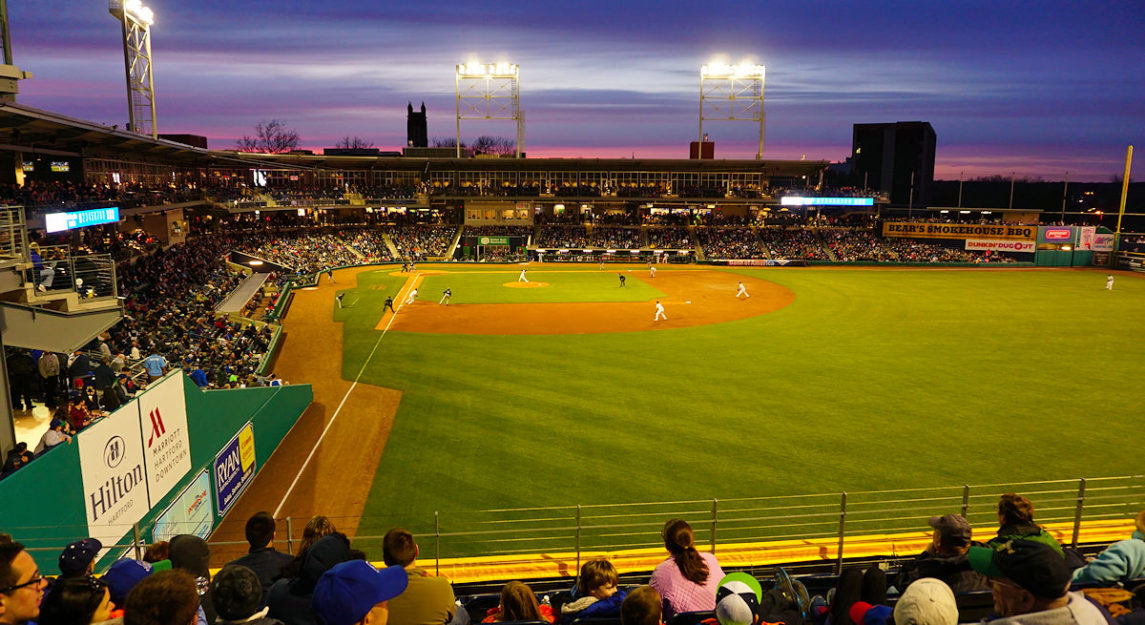Article and all photos by Joe Mock, BaseballParks.com
All rights reserved
Steve Goode has been a writer at the Hartford Courant for 25 years. During that time, he’s seen it all – including a series of broken hearts for the City’s sports fans. “We’ve had a losing streak here,” he told BaseballParks.com.
He mentioned that Hartford lost its beloved NHL team, the Whalers, when they moved to North Carolina 20 years ago. The New England Patriots acted as if they were going to move to town, but didn’t. “There was also a scandal here two summers ago when some guys were going to bring in Major League Soccer, but they were just stealing from the City,” he added.
| Ballpark Stats |
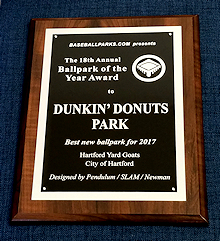 |
| Award: 2017 BaseballParks.com Ballpark of the Year. See press release here. |
| Team: Hartford Yard Goats of the Double-A Eastern League |
| First game: April 13, 2017, a 7-2 loss to the New Hampshire Fisher Cats |
| Capacity: 8,000, including 6,121 fixed seats |
| Dimensions: LF – 325; LCF – 357; CF – 400; RCF – 350; RF – 308 |
| Architect: Pendulum |
| Construction: Centerplan until June 2016, then Whiting-Turner |
| Price: $71 million |
| Home dugout: 3B side |
| Field points: East by Southeast |
| Playing surface: Kentucky bluegrass |
| Ticket info: yardgoatsbaseball.com/tickets or call 860-246-4628 |
| Interview: Listen to my thoughts on the ballpark |
| Betcha didn’t know: The two retired numbers on the batter’s eye are 42 for Jackie Robinson and 21 for Roberto Clemente (“He was a huge humanitarian and a real symbol for the downtrodden,” explained Yard Goats owner Josh Solomon) |
Last year, an Eastern League baseball team was supposed to move into a beautiful new ballpark on the edge of downtown Hartford, but a series of embarrassing delays and lawsuits forced the team to play its entire schedule away from home.
You could add that the area’s favorite college athletic team – the supposedly invincible University of Connecticut women’s basketball squad — was upset in the Final Four of the recent NCAA tournament.
“So Hartford’s been on a fairly long losing streak,” is the way Goode sums it up.
But now things are looking up. That baseball team has just moved into the ballpark – yes, it’s a year late and cost $11 million more than it was supposed to – and not only is it a source of local pride, it also has the potential to bring geographically and racially divided people together.
Consequently, Goode observed that “a lot of people are excited just to see something good happen here.” And Dunkin’ Donuts Park is something really, really good.
Before we analyze the facility, let’s look at the pothole-filled path that caused its opening to be delayed to April 13, 2017.
In 2012, Josh Solomon and his two siblings purchased the New Britain Rock Cats. Their father, Art, already owned two Minor League franchises, so the family was quite familiar with the business of baseball. Josh himself was quite successful in real estate investment, and his involvement in New Britain brought success at the gate for the Rock Cats. “My family has a love of baseball, and to turn it into something where you can make it an investment is unique,” he told the Hartford Business Journal in 2013.
An interesting opportunity came along in 2014 to move the franchise to nearby Hartford. While there is some disagreement over whether it was the City of Hartford or Rock Cats management that initiated the conversations, rumors started to fly in the spring of that year that the team would be moving once its lease ended at the end of 2015.
With the ballpark in New Britain nearing the end of its second decade, there were definitely renovations and modernizations that needed to be made. The allure of a brand-new park, without having to leave the metro area, was strong. In fact, the new park would only be nine miles away.
On June 4, 2014, Mayor Pedro Segarra of Hartford announced that the City would build a $60 million stadium for the Rock Cats in time for the 2016 season. One reason he cited for the project was to keep the franchise from moving out of Connecticut. Another reason was to revitalize the City’s downtown and “reconnect” it with minority areas in North Hartford. And he stressed that the City was paying for this, with no support from the State of Connecticut.
Fans in New Britain were stunned and angered. The City of Hartford started the process of firming up arrangements, while its citizens prepared for the arrival of baseball in 2016.
| What was left behind |
 |
| New Britain Stadium opened in 1996 during a time when exciting architecture wasn’t at all a requirement for an Eastern League park. |
 |
The City struck agreements with several firms. The architecture was to be done by Pendulum, out of Kansas City. A firm called DoNo Hartford was formed to handle the development of the area surrounding the stadium, and they had oversight over Centerplan of North Haven, CT, which was tabbed to do the construction. “Centerplan had built shopping centers, stores, plazas for the highway, office space — but no ballparks,” Goode noted.
The City Council gave its final approval to a $350 million project (ballpark plus development) on October 14, 2014. This led to ground being broken on February 17, 2015 on a sloping piece of property with a small parking lot and vacant land located on the northern edge of downtown Hartford. This was just over a year from the targeted completion date – a target that wouldn’t be hit.
True, it’s common for “value engineering” to take place on a project, where elements of a design are stricken from the plans to save money. Goode said when this happened in September of 2015, it waved a red flag – although a small one. In order to shave several million dollars off of the cost, a list of items was targeted by Centerplan to be eliminated or reduced, the primary one being the roof that was going to cover the right-field stands.
Other than approval to remove the roof from the plans, little came of this … until a seismic announcement was made in December. Centerplan announced that the project was $10 million over budget and was falling farther and farther behind schedule. Their executives contended that not enough of the list from September was approved by the City to be eliminated from the plans, plus the City and team were submitting “change orders” constantly, putting them behind and pushing the costs skyward. Goode concurred that the City had indeed requested a number of changes, but he also related that several City officials told him at the time that they believed Centerplan was in over their heads.
| Delayed opener #1 |
 |
| When the original opening day was pushed back to May 31, 2016, I booked a trip to Hartford. When it was then delayed indefinitely, I decided to make the trip anyway, since I was dying to see the park, even if it was unfinished. |
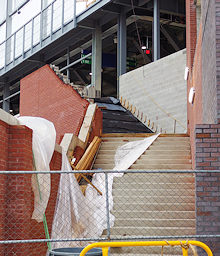 |
| What I found was a park that appeared to be 95% complete, possibly within weeks of being ready — but later evidence proved it wasn’t. |
This was just the beginning of the war of words.
An example of the complications came when a different HVAC system was chosen to save money. Unfortunately, it was installed too close to the edge of the stadium’s roof. After a building inspector assessed that this was in violation of building code, a fence had to be constructed to prevent workers from falling off the roof. “So,” Goode pointed out, “a lot of the change orders had other consequences that cost money and time.”
With opening day approaching, it was obvious the stadium wasn’t going to be completed in time. So the Eastern League announced that the Yard Goats (the Rock Cats’ new team nickname) would play the first seven weeks of the season on the road (although a number of games were played in Norwich, CT, with the Yard Goats being considered the home team) to give Centerplan time to get the stadium ready. The new timeline called for them to turn over the park to the team on May 17 so they could prepare it for a delayed home opener on May 31.
“May 17 came and went and the ballpark wasn’t ready,” Goode recalled. “A couple of weeks later, the Mayor decides to terminate the developer and all construction stops. That for all intents and purposes killed the season.” Indeed, the Yard Goats became the Road Goats, playing the entire 2016 season away from Hartford.
In July, Centerplan filed suits against the City and the Yard Goats, claiming that they had been terminated in a way that was not in their contract.
In August, the Courant filed a Freedom Of Information request to obtain records regarding the construction issues. According to reports generated by Centerplan from around the time the stadium was to be completed in late May, there were 180 problems in the park, with the implication being that Centerplan had been told to make many changes to the original plans.
The following month, the architects submitted a 344-page report. In it, each firm involved in the design and engineering provided their own list of issues, complete with hundreds of color photos. It was pretty damning, because many of the problems were a result of poor execution of the architectural documents.
| All smiles |
 |
| It was a very difficult year for Yard Goats owner Josh Solomon (above), one filled with challenges and delays. When April 13, 2017 arrived, though, those behind the look and feel of the park were all smiling (below). From left: Najib Habesch of BETA Group (handled street relocation and traffic issues); Rick Bouchard from SLAM (the local architects); Solomon; Jonathan Cole of Pendulum; Chris Sziabowski from SLAM (Cole refers to him as the “lifeblood of the team”) |
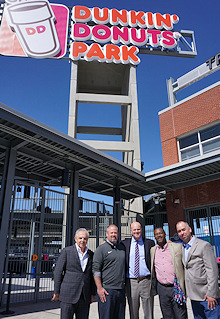 |
| Another critically important member of the design team is Pendulum’s Lauren Gripka. She was responsible for the decor, furnishings and signage (sometimes referred to as “way-finding”) within the park. |
While the delay was embarrassing and financially disastrous for the team’s ownership, it wasn’t without precedence. Land and construction complications forced the Eastern League’s Bowie Baysox to play in temporary homes throughout the 1993 season and for two months in 1994 before moving into a partially finished Prince George’s Stadium. The Winston-Salem Dash of the Carolina League were a year late moving into BB&T Ballpark, when delays pushed its opening from 2009 to 2010. A big difference, though, was that they could lease back their old ballpark and play a second lame-duck season there in 2009.
There was no such option for the Yard Goats to return to New Britain for another year, though, because the City had landed an independent league team to lease its ballpark. “New Britain wouldn’t have wanted them back anyway,” Goode explained. “It was a bad breakup.”
Another complication in Hartford was that Mayor Segarra, strong proponent of the team’s move to his city, had been voted out of office. His successor, Luke Bronin, was never a supporter of the City building the stadium. He took office with the $10 million shortfall hanging over his head.
Meanwhile, the insurer who was acting as the “surety” on the construction to guarantee its completion, Arch Insurance, took over the project. Since Centerplan had been dismissed by the City, Arch brought in noted construction company Whiting-Turner. By October, construction started again, and a month later, Arch sued Centerplan for $8.4 million for claims Arch had to pay to other parties.
The word “drama” scarcely describes what then played out in the press. It seemed each day, the owner of Centerplan and the Mayor of Hartford were hurling harsh words at one another. Says Goode, “They said things about each other in public that told you that there was no love lost there.” At least it made for entertaining reading.
Slowly but surely, guided by the steady hand of Pendulum and Whiting-Turner, the project got back on track. There was a huge sigh of relief when the Certificate of Substantial Completion was signed by the architect and structural engineer on April 4, paving the way for the debut of Dunkin’ Donuts Park on April 13, 2017. At that point, it was a year late and, as it turns out, about $11 million over the original budget of $60 million. But at least pro baseball was finally back in Hartford, after an absence of 65 years.
There were a lot of smiles on Opening Night. Was it a coincidence that it was 20 years to the day that the City’s beloved hockey team played its final game? There were certainly a lot of fans wearing Whalers jerseys to the Yard Goats’ first game in Hartford … and it is no coincidence that the Yard Goats’ team colors match the blue and green of the Whalers.
But was Dunkin’ Donuts Park worth all the drama, delays and dollars? Read on as we assess its location, its design and what the gameday atmosphere is like, and you can decide for yourself whether it deserves to be the 2017 Ballpark of the Year. If it is, then surely Hartford’s ugly losing streak is finally over!
The Setting
As soon as the announcement was made that the Rock Cats were moving to Hartford, reporters rushed to New Britain to ask baseball fans there what they thought of the move, and would they follow their favorite franchise up the road to their new park? Fan after fan expressed sadness and, interestingly, the sentiment that they would never go near downtown Hartford, especially with their kids, because it’s just not safe there.
“Yeah, there is a stigma that there is crime here,” Goode acknowledged. “I have friends who haven’t been into Hartford since the Whalers left because they say they don’t feel safe.”
No doubt, changing the region’s perception that Hartford is crime-ridden had to be in the minds of City leaders when deciding to build a baseball stadium where families would be flocking.
And when those officials started seriously considering a new ballpark, “they had four or five sites in mind,” Pendulum’s Jonathan Cole recalled. “Initially, they were looking for an architect with ballpark experience to work with their appointed program manager (Brailsford and Dunlavey) to assess the feasibility of each site. We were selected through an early request for proposal (RFP) process to complete the analysis which indicated this site would be the most appropriate to accomplish their goals to spark adjacent development and create a visual connection to the existing downtown.”
As is often the case with a new sports facility, Hartford wanted to build its new park in an area that needed revitalization – and this one definitely fit that bill. Downtown Hartford has long had an issue with the way two Interstate highways crisscross the center of town. Nearly all of the downtown office towers are located to the west of I-91 and south of I-84. Once you crossed I-84 going north out of the center of the City, you quickly reached the land that time forgot, with empty lots waiting for a better use to come along.
“The point where Main Street crosses over I-84 has for decades been a physical and psychological barrier,” notes a recent article in the Courant.
 |
| This is the view of the ballpark and its surroundings from the top floor of the Hilton, which is just south of I-84. The intersection at the park’s main entrance is Trumbull and Main. It’s easy to see the empty lots that are beckoning for development on either side of that intersection. |
“Look at any number of Minor League parks,” Cole continued. “The only thing that could go into its site and spark growth is a ballpark, because if it was prime developable real estate that didn’t require an anchor tenant, there’d be something else there.”
Trumbull and Main Streets run north through the business district, past many office towers with street-level delis and shops. Just after these two streets pass over I-84 (where there is a municipal “park” made almost entirely of concrete, where graffiti and skateboard riding are actually encouraged), they cross. It’s at this intersection where the main gates of Dunkin’ Donuts park are located.
“I’ve always believed that the best ballparks come from challenging circumstances,” Cole continued. “Those challenges started with the site. It’s only six acres, which means it was a very tight site, with slopes on all sides.” In fact, to make things work, Trumbull Street (and all of the utility lines underneath it) on the right-field side of the park had to be moved by a local engineering firm called BETA. “Hey, it’s an urban ballpark, and that’s the nature of the beast,” Cole concluded.
But, he added, the constraints of the site “actually made for some great seating options for the fans.” More on that in a bit.
As the ballpark is now complete, it’s interesting to note what is surrounding it. The attractive Capital Preparatory Magnet School as well as a (not-so-attractive) high-rise classroom building for Rensselaer Polytechnic Institute are across Pleasant Street on the northern side of the park.
Windsor Street used to run between Pleasant and Trumbull on the left- and center-field sides of the park, but it was closed to make a walkway. This is important, because on the other side of this walkway is a long-abandoned utility building which is clearly visible from within the ballpark. This building, though, will either be removed or completely retrofitted during “Phase Two” of the urban renewal process being kicked off by the ballpark.
On the southeastern side of the park on the other side of Trumbull is the high-rise Radisson Hotel, which is currently being renovated to convert half of its floors into apartments. The ones on the west side of the building will have a spectacular view into the ballpark.
And then there’s the other parcels of land adjacent to the park on its southern and western sides. For all intents and purposes, they are empty lots, used for parking – which the ballpark needs. These are not destined to remain empty, though, as there are big plans for them in Phase Two.
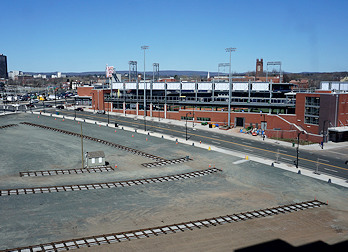 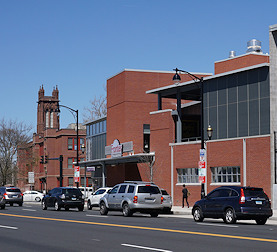 |
| On the left is the view from the Radisson. The empty lot in the foreground is currently being used for parking for games, but someday, this is one of the key parcels in the Phase Two development. On the right is the park’s exterior along Main Street with the Capital Preparatory Magnet School in the background. |
It’s handy that both northbound and southbound I-91 have exit ramps that lead directly onto Trumbull, making it extremely easy to get to the ballpark’s front door.
The Radisson isn’t the only hotel within walking distance. There’s a Hilton on Trumbull just across the overpass on I-84 (and plenty of others in Downtown Hartford), as well as a Candlewood Suites that’s due to open around August 1.
If you’re looking for points of reference, the Xfinity Theatre – an indoor-outdoor concert pavilion – is less than a mile to the north of the ballpark, and three blocks south is the XL Center, one-time home of the Whalers. Cole pointed out that a finalist for the location of the ballpark was next to a concrete plant on a rough-looking parcel between the Xfinity Theatre and the southbound lanes of I-91. Great visibility, yes, but with virtually no connection to downtown. Glad that wasn’t chosen.
But it’s important to note that just north of the magnet school’s campus is a working-class neighborhood of small houses and tenements. Technically it’s called Clay Arsenal, but locals typically refer to this as the North End. A significant reason for the park’s location is so it can act as a bridge to this economically challenged – and some would add neglected — neighborhood.
Solomon told me an interesting story on the ballpark’s opening day. “A lot of our gameday employees come from that neighborhood. When we had an orientation for them here at the park the other day, I saw one lady sobbing. I ran up to her and said, ‘Ma’am, what’s wrong? Are you OK?’ Through her tears, she said, ‘I just can’t believe that anything as beautiful as this park is in my own neighborhood!’”
The Exterior
One of Dunkin’ Donuts Park’s many redeeming features is the variety in its architecture. Not only is this abundantly true as you walk around the 360-degree concourse inside the park, it’s also true on the outside.
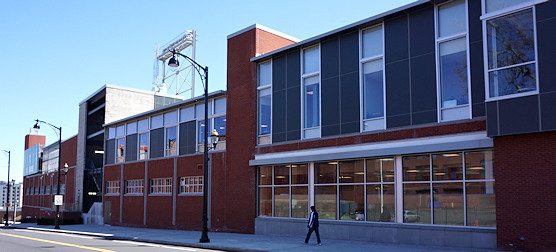
Most of the structure adjacent to the side streets is two stories tall, but the use of brick, concrete panels and windows provides a pleasing visual change of pace as you explore the park’s perimeter. In particular, the brick is very compatible with the magnet school across Pleasant Street. “We wanted the look to be authentic and real to Hartford,” Cole revealed.
And in a nod to the students across the street, the team hung a billboard on the side of the park that faces the school. Under photos of people of various ages, genders and colors – all wearing baseball-themed attire in Yard Goats colors, of course – are the words BE AMAZING.
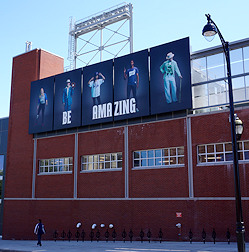 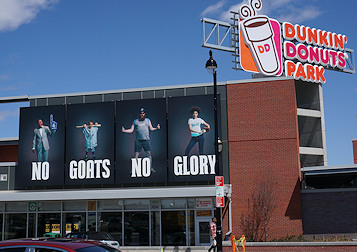 |
Not to be outdone, the exterior that greets traffic going north on both Trumbull and Main out of downtown has a similar billboard. Its message: NO GOATS NO GLORY.
Clever folks these Yard Goats.
But back to the height of the ballpark. “It’s a tall building. There was an exhaustive planning/zoning approval process, and one of the things they wanted was for the scale of this ballpark to be urban,” Cole explained. “So we needed it to be a minimum of two stories tall, with a story being defined as 16 feet. That’s so it fits its surroundings. For example, the XL Center is anywhere from 32 to 45 feet tall, so that’s why the stadium is a minimum of 32 feet tall.”
The main entryway for the park (below left), where there’s a small plaza with ticket windows on one side, certainly isn’t overdone. And it fits well with the nearby cityscape. This will undoubtedly be even more important as Phase Two of the urban renewal takes shape right across the street. Near this entryway is the merchandise store, and it’s intelligently placed with doors that open both to the inner concourse and the street.
  |
There is a wonderful feature on the Trumbull Street side (above right). “There is glass along the sidewalk where you can look right into the home bullpen,” Cole explained. “And when you look beyond the bullpen, you’re seeing the playing field. Now, this is reminiscent of San Francisco (AT&T Park), but there are always things you see repetitively at ballparks. To me, the magic comes in how you execute those ideas.” And this look into the inner workings of the game from the exterior is executed really well.
“These are real ideas that were formed as we walked the site (before construction).”

Now let’s take a look on the inside of Dunkin’ Donuts Park.
